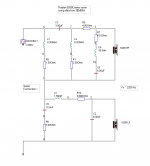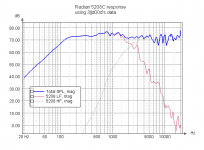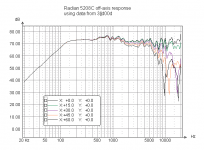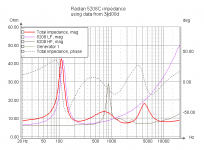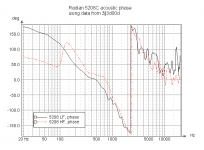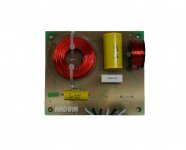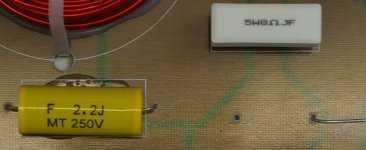Are R6 and R3 actual resistors?? Are the DCR resistances based on available inductors then? Thanks again!!!
Silly question: Those resistors in series with the inductors are the actually dc resistance of the inductors and not additional series resistance correct?
On TerryO's series design, the resistance shown in series with each inductor is the total combined resistance of the coil and a separate resistor. For example, if L7 (.4 mH) has a dc resistance of 0.33 ohms, then R8 would be a separate resistor of 1.17 ohms, to make 1.5 total. etc This is just an example to clarify. Depending on wire gage, the dc resistance could be more or less.
Sorry for the confusion. It's just easier to run the sim that way, and then go scrounge through the parts bin for a coil that is suitable. (tolerance of 5 or 10% is often close enough)
Are R6 and R3 actual resistors??
For R6 and R3 in the series xover design, the values are for actual resistors.
C2 and C5 are capacitors, with negligible resistance of their own.
wow a lot of replies to digest. It looks like the Fs is a little higher than the published specs. does anyone have any copies of galante rhapsody xover design?
AudioGeek,
I don't have any of the original data and notes from that time anymore, so this is all from memory, but I believe that the Galante "Rhapsody" speaker used a 2nd order crossover that was very close if not identical to the Radian crossover that was available at the time. I had spoken with one of the Radian Engineers and he confirmed that Galente was using the stock Radian crossover. That may have changed later, but at that time they were using the off the shelf item.
Hope this is of some help,
TerryO
that helps a lot. Just unsure why there is a big difference between Fs of both specs. nearly 20Hz.
I may get some of these drivers and try out that series x-over.
I may get some of these drivers and try out that series x-over.
do you mind me asking what size enclosure are you using with the Radian? I have WinISD and will run the simulation. Thanks!
Also it was mentioned that the acoustic phase could be improved in the series crossover. I would be very interested in this. I was actually thinking about a series crossover for this driver awhile back but never really researched it that much.
Is a first order series crossover out of the question? Just wondering....
Is a first order series crossover out of the question? Just wondering....
do you mind me asking what size enclosure are you using with the Radian? I have WinISD and will run the simulation. Thanks!
I don't mind at all, although it probably won't help you very much. I'm presently using a 24 X 24 inch Open Baffle with the driver offset by 6 inches in one plane. My plan is to mate it with an 18 inch woofer on a separate OB Panel with "wings". The plan is to attempt to run the woofer with either a subwoofer amp or maybe off the main amp (a 45 Triode /SS hybrid pure class A amplifier w/ approximately 16-17 watts).
Best Regards,
TerryO
hmmm not too much help lol. looking to do a BR... but i don't know what tuning f or enclosure size i should do... should i do optimal flat response or shelf it down a bit and have lower tuning frequency?? port probably on back of enclosure.
Also it was mentioned that the acoustic phase could be improved in the series crossover.
If you are referring to post #32, I was referring to possible improvement to the acoustic phase for the series crossover using data files supplied by
3||3d00d. The phase shown on that post using TerryO's data is about as good as it can get, IMHO.
For whatever reason, 3||3d00d's data was somewhat different for his set of drivers vs. TerryO's. Due to that, the series crossover that works well for TerryO's doesn't seem to work as well for 3||3d00d's. A few tweaks to component values, etc. might get them to a similar point, and with improved acoustic phase.
Is a first order series crossover out of the question? Just wondering....
Nothing is out of the question. A first order is obviously less expensive, and usually a starting point. But in TerryO's case, it took more components to achieve the end result.
Probably you don't need help, I could give a look at sims.😀hmmm not too much help lol. looking to do a BR... but i don't know what tuning f or enclosure size i should do... should i do optimal flat response or shelf it down a bit and have lower tuning frequency?? port probably on back of enclosure.
3||3d00d,
Here's a series result using the "design zip" file that is on Post #14.
The basic topology is the same as the one used on TerryO's, but with a few changes to components. See my earlier post regarding resistor values in series with inductors in the circuit.
The acoustic phase looks good. And the impedance seems to be an easy load.
Here's a series result using the "design zip" file that is on Post #14.
The basic topology is the same as the one used on TerryO's, but with a few changes to components. See my earlier post regarding resistor values in series with inductors in the circuit.
The acoustic phase looks good. And the impedance seems to be an easy load.
Attachments
hmmm not too much help lol. looking to do a BR... but i don't know what tuning f or enclosure size i should do... should i do optimal flat response or shelf it down a bit and have lower tuning frequency?? port probably on back of enclosure.
With such a high Fs, semi-high Qts, it ideally needs a large pipe horn if vented or a separate 'sub' system and/or a hi-pass filter to protect it below tuning if a BR.
Anyway, you say you want 'bookshelf' speakers, so a rear vent is not normally a good plan unless the shelf is deeper than average and/or is open and spaced away from a wall, corner.
Using the specs in post #13, a T/S max flat alignment is ~5.4 ft^3/~73 Hz [both varies a bit depending on the program formulas used], qualifying it as a vintage sized 'bookshelf' speaker, so at this point you need to tell us what's the largest you can tolerate or load it into a program and find the tuning required to get the flattest response, which will probably be too low, requiring either an inverse tapered TL or sealed alignment.
GM
I guess bookshelf to me is stand mounted speakers. I will look again at the T/S parameters. The Galante Rhapsody was small around 1 cu foot I do believe.
3||3d00d,
Here's a series result using the "design zip" file that is on Post #14.
The basic topology is the same as the one used on TerryO's, but with a few changes to components. See my earlier post regarding resistor values in series with inductors in the circuit.
The acoustic phase looks good. And the impedance seems to be an easy load.
thanks for taking the time to do this, I haven't looked at series crossovers before (that one is only 2nd one I've designed full stop) so it will be an interesting one to understand (and to listen to and compare of course)
Last edited:
I guess bookshelf to me is stand mounted speakers. I will look again at the T/S parameters. The Galante Rhapsody was small around 1 cu foot I do believe.
Well, if these specs are accurate, then a T/S max flat alignment plumments to ~0.87 ft^3/~75 Hz, but FWIW, it's been many folk's experience with most brands that Vas, and especially Qts, is somewhat higher in reality, so while many DIYers/consumers seem happy with its performance when the cab is technically too small, I've yet to see/hear any complaints about them being too big, though sometimes they have to tune them lower or damp the vent a bit: Radian Audio 5208C Coaxial Speakers - Radian Dual Concentric 5208C 8" time aligned coaxial speakers. Radian 5208C coaxial speaker - Radian 5208C coaxial speaker handles 200 watts RMS. Radian 5208C 8" coaxial driver is available here. Radian coaxial s
Anyway, if the 'big' specs are fairly accurate, then in a 1.0 ft^3 cab I calculate a ~138 Hz F3/122 Hz Fb before tuning it lower, so going to have some mid-bass/lower mids baffle step compensation [BSC] built in, so we're back to using a long vent to 'tone it down' and even then may need some stuffing in it.
GM
I plugged the schematic you provided into xsim and it only seems to agree with your sim if z offset is 0. I calculated as the W needing ~9.6cm of delay, apologies for not making this clear.3||3d00d,
Here's a series result using the "design zip" file that is on Post #14.
The basic topology is the same as the one used on TerryO's, but with a few changes to components. See my earlier post regarding resistor values in series with inductors in the circuit.
The acoustic phase looks good. And the impedance seems to be an easy load.
Do you think it would be better to add an extra 8 or 10in driver for bass? If not what cabinet alignment would work best? I ran the numbers in my winISD and I came up with about 1.6 cu ft enclosure and a tuning of around 70hz.
Using which specs? I don't have any simming programs on this computer, so can only calculate a few things.
Regardless, again, its Fs dictates either some form of horn to low tune it or ideally a separate 'sub' system to be 'full-range' enough to probably not need any hi-pass protection unless only played at low power, so adding a [mid] bass woofer using a mini DSP or similar is a good plan; ditto mounting the Radian in an OB and maybe the woofer also depending on the room and personal preference, i.e. wouldn't hurt to first try a quick, simple, OB before deciding on some form of box alignment.
GM
Regardless, again, its Fs dictates either some form of horn to low tune it or ideally a separate 'sub' system to be 'full-range' enough to probably not need any hi-pass protection unless only played at low power, so adding a [mid] bass woofer using a mini DSP or similar is a good plan; ditto mounting the Radian in an OB and maybe the woofer also depending on the room and personal preference, i.e. wouldn't hurt to first try a quick, simple, OB before deciding on some form of box alignment.
GM
T/S parameters: Sd doesn't look correct from either sources. Can someone post the correct diameter (or area) of the diaphragm? (I calculated an area of approx. 225 cm2 w/o measuring.)😕
post #13
Radian@usspeaker
Below the 2. order crossover from Radian with HF atten. 8R0 in series with 2.2uF - Radian 322/08B-2. (Not certain about/if the same component value, being an old picture.)😀
post #13
Radian@usspeaker
Below the 2. order crossover from Radian with HF atten. 8R0 in series with 2.2uF - Radian 322/08B-2. (Not certain about/if the same component value, being an old picture.)😀
Attachments
- Home
- Loudspeakers
- Multi-Way
- Radian 5208c coaxial project
